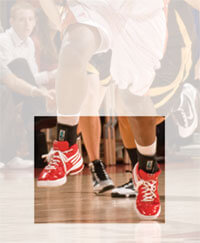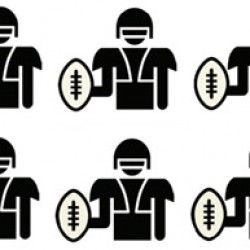Brace Yourself

A UW study suggests that braces such as these protect ankles and don’t lead to an increase in knee injuries. Photo: UW Sports Information
A UW trainer leads a first-of-its-kind study on the effectiveness of ankle support.
Every time an athlete sets foot on the basketball court, the risk of injury follows — especially ankle injuries, with the sudden stops and cutting moves associated with the game. Yet many players are confused about the best way to prevent such damage. Should they wear ankle braces for additional support? Will those braces increase the risk for other types of injuries? Do ankle braces even work at all?
The reason for the confusion is that up until now, no comprehensive studies had been performed to determine if wearing ankle braces reduces the incidence of injury.
“You have companies marketing braces designed to prevent or treat injuries with no evidence to back up their claims,” says Tim McGuine MS’86, PhD’05, UW Health Sports Medicine researcher and athletic trainer.
On the other end of the spectrum are physical therapists and chiropractors who tell kids that they should never wear any sort of ankle brace. If you lock down the ankle when it’s supposed to be moving, they fear, you will transfer that force up the kinetic chain and inflict knee injuries such as ligament tears.
“We said, let’s finally figure this out,” says McGuine, who led a study of the effects of lace-up ankle braces that was recently published in the American Journal of Sports Medicine. Of the 740 male and female players randomly assigned to wear lace-up ankle braces, 27 suffered an ankle sprain or fracture over the course of one basketball season. In contrast, 78 ankle injuries were reported among the 720 teenagers who played and practiced without a brace — a rate that was nearly three times higher.
“What surprised me was the effect ankle braces had on what we call virgin ankles — ankles that hadn’t suffered an injury in the past year,” McGuine says. “I didn’t expect to see those rates of injury to be lower, too, but they were.”
Further, he says, “We found no evidence of higher knee injury risks.”
According to McGuine, protecting ankles is one way to control spiraling healthcare costs. When kids suffer ankle injuries, they’re likely to experience long-term negative consequences, such as arthritis, that affect their ability to remain active as adults.
“We’ve got to start changing the way we look at these injuries,” he says. “These aren’t sports injuries; these are public health policy issues.”
Published in the Winter 2011 issue



Comments
Ron Larsen January 7, 2013
Common sense says that if your ankle is immobilized your knee joint will be the next to go. Your study was done on College athletes. Some poor father of a middle school student, reading your article, will put their child’s knee in danger.
My grandson at age 14 has a knee injury due to his required ankle brace.
Perhaps you need more studies than a one of a kind.
Chris Mackenzie December 2, 2013
A large study concluded that wearing ankle braces did not increase the incident of Knee Injuries, so it’s difficult to say that what your grandson experienced is due to any effect of the ankle braces. That can be found here:
http://www.sciencedaily.com/releases/2012/04/120425093936.htm
Of course, for one, the ankle is *not* immobilized, only far ranges of motion are restricted. Two, the ankle and the knee work differently, so forces across the ankle and thus helped by bracing don’t translate to forces across the knee much in the same manner.